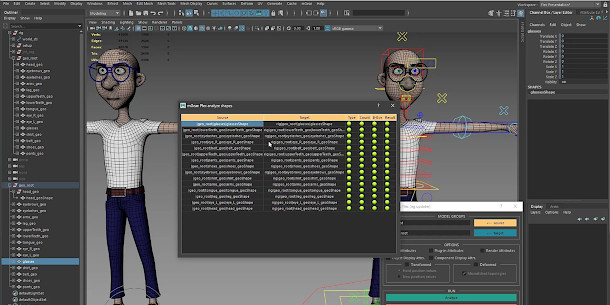mGear team ships mGear 3.7

Originally posted on 17 January 2019. Scroll down for news of the 3.7.8 update.
Character TD Miquel Campos has released mGear 3.0: the latest update to his versatile open-source character rigging framework for Maya.
The release introduces Flex, a new tool for updating the geometry of a previously rigged character, and updates Shifter, mGear’s modular auto-rigging system.
Updated: Miquel has been in touch to say that mGear is now a team project. Flex was created by rigging artist Jérôme Drese.
A versatile framework for creating modular character rigs
First released in 2015, mGear is based on Gear, Blur Studio technical animation supervisor Jeremie Passerin’s Softimage rigging framework, although it isn’t an exact copy.
It provides character artists with a library of customisable rig components for different body parts, and is intended to generate “an infinite variety of rig combinations … without programming knowledge”.
Flex automatically updates the geometry of a character without breaking the rig
New features in mGear 3.0 include Flex, a new tool for updating the geometry of a rigged character without breaking the rig, as shown in this video.
Users specify matching geometry groups on the source and target models manually, then mGear identifies individual matching parts automatically, based on part name, poly count and bounding box geometry.
As well as geometry changes, mGear can transfer UV updates between versions of a character.
The plugin provides a fair degree of granular control: as well as native Maya attributes, users can choose to transfer those from plugins like Arnold, or custom attributes.
Shifter auto-rigging system gets new components, more game-friendly output
The release also updates Shifter, mGear’s modular auto-rigging system.
Games artists now have the option to separate the character rig from the character mesh, making it easier to export the character to a game engine in FBX format.
There are also new options itended to make the elbows and knees of rigged characters more compatible with common game engines.
In addition, mGear 3.0 introduces a range of new components for Shifter, including a chain FK spline with variable IK controls, a chain IK spline with variable FK controls, a whip chain and an FK spine.
Updated 9 March 2021: The mGear team has released mGear 3.7.8, a significant update to the framework that improves its integration into game development pipelines.
New features include the EPIC components, a new set of Shifter components intended for use with game engines. They are specifically designed for Unreal Engine, but can be used with “any other engine”.
Shifter also gets two new biped templates to match the joint structure and naming conventions of the UE4 Mannequin and Epic Games’ new MetaHuman characters.
The update also introduces Plebes, a new tool that automatically generates a base mGear rig for characters created in DAZ Studio, Reallusion’s Character Creator and open-source tool MakeHuman.
It is also possible to auto-rig characters imported from Adobe’s Mixamo library.
Other new features in mGear 3.7 include XGen IGS Boost, a new tool for creating curve-based hair grooms in Maya’s XGen toolset.
Availability and system requirements
mGear is available now via an MIT licence. The framework works with Maya 2018+ running on Windows, macOS and Linux. The rigs are compatible with tools that import native Maya character rigs, like Rumba.
The source code was refactored for mGear 3.0, which may break backwards compatibility with previous releases. You can find more information in the videos on the mGear YouTube channel.
Read a full list of new features in mGear 3.7.8 in the online changelog
